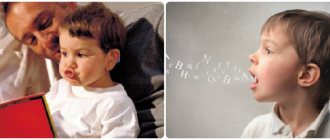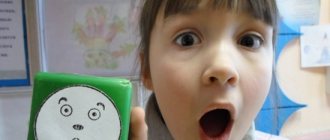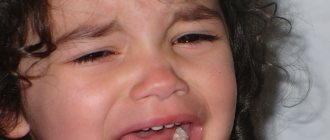How does erased dysarthria manifest in children?
A feature of erased dysarthria is the lack of expression of symptoms, which is why the disease is called that. Characterized by unclear articulation due to impaired motor skills, distortion of some sounds. The lack of intonation and inexpressive speech and the complexity of automation are noteworthy. The clinical picture may vary depending on the affected area: in one child the phonetic defect predominates, in another the prosodic defect predominates, in the third both components are present in equal volume.
Sound pronunciation disorder affects two or more groups of sounds. For example, hissing, whistling and sonorous. Speech with erased dysarthria is replete with distortions and replacement of sounds. The baby confuses dull, voiced, and soft sounds and cannot use them correctly. Even if you can overcome these problems, it is difficult to achieve automaticity.
At an early age, such children are usually observed by a neurologist. They are diagnosed with “perinatal damage to the central nervous system” and are given medication, courses of physiotherapy and massage. Over time, the child is removed from the register. Only when speech disorders do not go away do parents and doctors begin to look for the cause. As a rule, erased dysarthria is diagnosed in preschool children - at 5 - 6 years old.
Characteristics of the erased form of dysarthria, which parents themselves can notice, are poor facial expressions, lack of tone of the lips, tongue, asymmetry of the nasolabial folds and corners of the mouth. When performing articulation tests, involuntary movements of the tongue, its trembling and cyanosis occur. Increased salivation. It is difficult to keep the speech organs in one position.
It may be difficult for the baby to chew food, and he refuses to eat if it is in pieces. Infants have difficulty sucking milk and swallowing is impaired.
General development
Neurological status has changed. Noteworthy are persistent dermographism and sweating of the hands and feet. Children are easily excitable, restless, and make a lot of unnecessary movements. Or, on the contrary, they are inhibited and slow. Their memory and attention are impaired.
Physically, children lag behind their peers and are short, thin, and asthenic in build. They get tired quickly during physical activity and are clumsy. The synchronization of movements and fine motor skills suffer. It’s hard for a child to fasten a button, tie shoelaces, or do creative work. In physical education lessons he has difficulty completing assignments. Handwriting is impaired, and in general the child writes slowly.
Causes
The causes of dysarthria are directly related to diseases that affect the posterior parts of the frontal zone and other parts of the brain. Speech reproduction is impaired due to difficulty moving the tongue and lips. In childhood, in almost all cases, written speech, perception of sounds and reading abilities change.
In adults, such phenomena are observed much less frequently. Dysarthria often occurs during intrauterine development. The factors that caused the disease are gestosis (late toxicosis), oxygen starvation of the fetus, chronic diseases of the mother, injuries received during childbirth, prematurity, suffocation at birth, cerebral palsy (cerebral palsy).
At an early age, the disease is diagnosed due to previous purulent otitis media, meningitis, severe poisoning, hydrocephalus, increased intracranial pressure, as well as traumatic brain injuries. In adults, dysarthria results from:
- Tumors of the brain or cerebellum;
- Cerebrovascular accidents;
- Demyelinating disease (brain disease);
- Having suffered a stroke;
- Syphilitic lesions of the spinal cord or brain;
- Traumatic brain injuries;
- Abscess (purulent inflammation) of the cerebellum;
- Severe poisoning with poisons;
- Parkinson's disease (shaking palsy);
- Multiple sclerosis;
- Severe infectious pathologies;
- Hemorrhages in the brain;
- Serious disorders of the nervous system;
- Autoimmune neuromuscular disease;
- Cerebrovascular diseases;
- Fazio-Londe syndrome (juvenile paralysis);
- Mental retardation (oligophrenia).
In adults and older people, the disease most often occurs suddenly due to a prolonged period of unconsciousness (coma after a traumatic brain injury or major stroke). Dysarthria is often caused by improperly performed brain surgery and botulism (a disease associated with poisoning).
Pathology can also appear due to excessive consumption of alcoholic beverages, improper use of certain groups of medications, and drug overdose. High-risk groups include children under 2 years of age, adolescents and the elderly. At a young age, pathology is diagnosed, but not so often.
The disease is acquired in nature; as a rule, it does not have a genetic predisposition. Only pathologies of brain development that contribute to the occurrence of dysarthria can be inherited.
Causes of erased dysarthria in preschool children
The main reason for the erased form of dysarthria is a violation of the innervation of the muscles of the lips, tongue, and soft palate.
Such disorders are caused by organic brain damage in various periods of child development:
- During the prenatal period, the fetus can be negatively affected by infectious diseases of the mother (herpes infection, rubella, toxoplasmosis, viral hepatitis, cytomegalovirus infection). Immunological incompatibility of the fetus and mother, toxicosis, decompensated diabetes mellitus or gestational diabetes play a role. As a result of these conditions, fetoplacental insufficiency develops, the fetus experiences oxygen deficiency, that is, hypoxia;
- During childbirth, traumatic injury is possible as a result of rapid or protracted labor or the use of obstetric forceps. A long anhydrous period has a negative effect;
- In the postpartum period and in the first year of a child’s life, damage to the central nervous system can occur due to injuries, infectious and other severe diseases, inflammatory diseases of the substance and cerebral cortex.
All of these factors lead to damage to the nerves that innervate the muscles of the articulatory organs: trigeminal, facial, glossopharyngeal, sublingual. Each nerve has its own characteristics. For example, damage to the trigeminal nerve is indicated by limited movements in the lower jaw, lips, tongue, facial nerve - facial muscles, glossopharyngeal nerve - root and back of the tongue, hypoglossal nerve - impaired tongue motility, difficulty raising the tongue to the palate.
Diagnosis of erased dysarthria
Erased dysarthria is diagnosed using a number of medical and pedagogical studies. Be sure to study the child’s medical history, as well as the course of pregnancy and childbirth in the mother. An analysis of the outpatient card is carried out: the results of instrumental diagnostic methods may be needed.
The examination is phased and includes:
- Speech therapy examination involves assessing the state of motor skills, facial muscles, articulatory apparatus, and speech breathing. After this, the speech therapist studies the quality of sound pronunciation, vocabulary, grammar, and the ability to capture various sounds. If an erased form of dysarthria is suspected, the patient is referred for consultation to a neurologist;
- An examination by a neurologist is needed to identify the nature of the disorders - hyperkinesis, paresis, dystonia, atony. The doctor also determines the location of the brain lesion. To clarify the diagnosis, EEG, electroneuromyography, CT, and MRI are prescribed.
After the baby has passed all the examinations, he will be consulted again by a speech therapist/speech pathologist. Having the conclusions in hand, he determines the type of speech disorders and draws up a plan and form of work with the child.
Forecast
The prognosis directly depends on the severity of the disease and how quickly therapeutic measures were started. If you follow all the specialist’s recommendations, complete restoration of speech with erased dysarthria is possible, but treatment requires a serious approach. You should not miss classes with a speech therapist or take prescribed medications.
Severe forms of pathology, unfortunately, in almost all cases leave consequences, but they can be minimal if the right treatment is selected. For children with severe speech disorders there are special kindergartens with speech therapy rooms and consultations with highly specialized specialists (neurologist, psychologist, massage therapist).
If the pathology is congenital, it is necessary to take all measures to prevent the progression of dysarthria - avoid injuries, visit a speech therapist, and avoid contact with aggressive substances that can lead to severe intoxication.
Note. It is easier to prevent a disease than to eliminate its negative consequences later. Therefore, measures to prevent dysarthria have an important role in a person’s life.
Treatment of erased dysarthria
The therapy is complex, carried out with the participation of a neurologist, psychologist and speech therapist. This tactic allows you to achieve a positive result, consolidate it and compensate for the speech defect.
The medical side of correctional work is to stimulate brain metabolism, which is achieved by prescribing nootropics and vitamins. The effect is strengthened by courses of massage, therapeutic exercises, reflexology, and physiotherapeutic methods. If possible, you can get medicinal baths and visit the pool.
Features of moderate dysarthria
The average severity of dysarthria is already characterized by gross defects in pronunciation, facial expressions, chewing and swallowing.
Speech with this degree of dysarthria becomes inarticulate, blurred, and incomprehensible. Children with moderate dysarthria are educated in specialized schools. After a certain time, relatives get used to it and begin to understand the patient’s speech. Facial expressions with a moderate degree of dysarthria are poor. In most cases, drooling is observed. Eating is difficult due to defects in chewing and swallowing.
Working with a speech therapist
At the initial stage, the speech therapist “sets” defective sounds and corrects other speech disorders. Then comes the consolidation of the normal pronunciation of sounds: the baby learns to use them in syllables, words, phrases. It usually takes a long time to overcome erased dysarthria. Automating sounds is a complex form of work that requires patience and effort.
At the same time, the specialist eliminates phonemic disorders, develops intonation and expressiveness of speech, and teaches grammar.
One of the components of correctional work for latent dysarthria is speech therapy massage. Probe massage is very effective. It allows you to normalize the tone of the muscles involved in articulation, helps the baby to feel them better when speaking, which means to control the position of the speech organs during sound pronunciation. Conducted separately or in parallel with the main course.
Finger and articulation gymnastics are effective:
- The coordination of hand movements is associated with the articulatory function, so a lot of time is devoted to finger gymnastics. It can be supplemented with play-based activities. For example, the child is asked to collect beads, puzzles, build construction sets, sculpt, and cut out. Of course, it is important to choose a complex that the patient enjoys and enjoys;
- Articulation gymnastics helps strengthen muscles. After them, it is easier for children to give the correct position to the speech organs during sound reproduction and switch to other sounds.
Breathing exercises are also shown - it trains breathing, teaches the child to correctly use a stream of air when speaking, and makes speech more expressive.
Corrective work for erased dysarthria is long-term: up to 1 year or more. The timing depends on the severity of the disease, concomitant speech disorders, and regularity of classes.
Role of parents
With erased dysarthria in preschoolers and primary schoolchildren, the role of parents is invaluable. After all, it is important to strictly follow the doctor’s recommendations and treatment plan. The result depends on this and how soon your child will start talking normally. If your doctor deems it necessary, do the exercises at home: this will speed up your recovery. But don’t overdo it, make sure your baby is in a good mood during homework. Now he is not in the mood for classes, so put them off.
The baby also needs your support. He must know and feel that he is not alone with the problem, that his dad and mom are nearby, who will always understand, support, and take care of him. It is important for a child to know that he is loved, despite his speech impediment. This way he will work harder and it will be easier for you to achieve the effect.
Possible complications
Disorders in the erased form of dysarthria cause defects in the perception of sounds. At the same time, the perception of not only similar-sounding phonemes, but also other sounds is impaired. Over time, the lack of clear speech and the impossibility of normal auditory perception leads to difficulties in understanding the syllable structure.
There are problems with grammar and poor vocabulary. If timely correction is not started, then younger schoolchildren’s writing will suffer.
In children, even with minimal characteristics of an erased form of dysarthria, communication skills suffer. They cannot build a dialogue and generally talk with people. They avoid groups, try to avoid new acquaintances and communication in general. If they attend kindergarten, they play alone. They are also kept apart at school.
This creates the preconditions for psychological problems and secondary speech disorders. For example, children may begin to stutter and develop enuresis.
Symptoms
Symptoms are quite extensive, divided into speech and non-speech, and also vary depending on the type of pathological process. Impaired articulation manifests itself in excessive tension, hypotonicity (weakening) or involuntary contraction of muscles.
Spasticity (a feature of the behavior of muscle tissue) of muscles causes increased tension in the articulatory organs (lips, tongue, palate). Also among the main manifestations is hypertonicity of the muscles of the neck and face. Due to partial paralysis of the palate, a change in voice occurs. The consequences of muscle weakening are limited tongue movements, a half-open mouth, and increased salivation. In addition to these manifestations, there are symptoms characteristic of a certain type of dysarthria:
- Bulbarnaya. There is a loss of voice ringing, slurred speech, as well as disturbances in visual functions, nervous system, speech breathing and muscle tone. With bulbar dysarthria, patients find it difficult to close their eyes and move their eyebrows. Voiced sounds, as a rule, are absent, and voiceless sounds predominate. If the lesion is unilateral, asymmetry of the oval of the face may appear. At the initial stage, it is difficult to take in liquid because when swallowing it can enter the nasal cavity. As the pathological process develops, problems with eating arise. Patients often complain of headaches, dizziness, nausea and lethargy.
- Pseudobulbar. The patient's speech becomes sluggish, inarticulate, and abrupt. The pronunciation of the sounds “sh”, “ts”, “ch”, “sch” and “r” is significantly difficult. Due to the excessively high tone of the tongue muscles, hissing sounds are softened, and the letters “i”, “e”, “s” are distorted and become more “hard”. It is almost impossible to compress the lips tightly, so saliva leaks from the corners of the mouth. In infants, sucking reflexes are disrupted and problems with swallowing occur.
- Cortical. Characteristic symptoms are difficulty in pronouncing consonant sounds, words or phrases are drawn out, the voice becomes nasal, as if the person is speaking “through the nose.” Due to damage to the tip of the tongue, it is difficult to pronounce the front-lingual sounds - “t”, “d”, “s”, “z”, “l”. Children have difficulty concentrating, writing and reading. Adults often experience depression due to deterioration in speech abilities.
- Extrapyramidal. Symptoms of extrapyramidal dysarthria include disturbances in the psychoemotional state, slurred phrases, and repetitions of certain sounds. Often the patient pronounces sounds similar to the syllables “gy” and “ky”. Involuntary muscle contraction leads to a forced smile and opening of the mouth. In this case, there is increased salivation and accumulation of saliva in the corners of the lips. Speech tends to change. It either speeds up or, on the contrary, slows down.
- Cerebellar. The disease manifests itself as a disorder in the smoothness and rhythm of pronunciation of words, as well as a lack of stress. When pronouncing long vowels, the patient's voice trembles. Inconsistency in voice strength often occurs. Speech is usually difficult, the person is in a tense state due to the inability to pronounce certain sounds. Hyperhidrosis (excessive sweating) appears. In most cases, coordination of movements is impaired, and chewing solid food is difficult.
Young children suffer more severely from the disorder than adults. This is explained by the inability to speak correctly. Often a sick child loses a sense of confidence and becomes withdrawn.
To avoid the disease progressing to a severe form, when the first symptoms are detected, you must consult a doctor as soon as possible. The inpatient unit at the Yusupov Hospital operates around the clock, so the patient will receive timely medical care even at night.
Make an appointment
Prognosis and prevention
Any speech defect, including an erased form of dysarthria in preschool children, entails psychological disorders. If the disorder is not detected in time, diagnosed and therapy is not started, the baby will grow up with this pathology, and others will join it. In such situations, it is difficult for a person to live in society: he is limited in his choice of profession and self-realization. Because of this, he may feel depressed, which can further lead to depression.
Prevention of erased dysarthria begins during pregnancy planning. The expectant mother needs to undergo examination at this stage and prepare for conception: undergo a course of treatment, if there are any problems, eliminate deficiency conditions (anemia, hypovitaminosis).
After pregnancy, you need to be careful about your food choices and daily routine. The expectant mother should have enough rest, walk, avoid physical strain, injury, and stress.
It is important to competently manage labor and avoid injuries and hypoxia. During the newborn period, follow the doctor’s recommendations and undergo examinations on time. If you suspect any developmental abnormality, tell your doctor. Timely diagnosis and therapy are mandatory conditions for the earliest possible recovery and a guarantee that the disorder will not affect the baby’s development in the future.
Features of mild dysarthria
With a mild degree of dysarthria, there are no gross violations.
In the first degree of dysarthria, articulatory motor skills are inaccurate and slow. The speech is understandable, but a certain defect is still noticeable. Because of it, communication is disrupted. Patients prefer to speak using short words and sentences. Neurotic disorders often occur due to speech impediments. In children whose speech function is just beginning to develop, a diagnosis of mild dysarthria should be immediately treated to prevent general underdevelopment of speech function in the future. Untreated dysarthria will lead to impairment of written speech in the future. If speech disorders in childhood are not corrected, in the long term this will lead to a delay in the child’s mental development. Children with mild dysarthria receive education in secondary schools.
There are no gross defects in chewing and swallowing, but choking and coughing are sometimes observed. The patient's facial expressions are usually not impaired.









